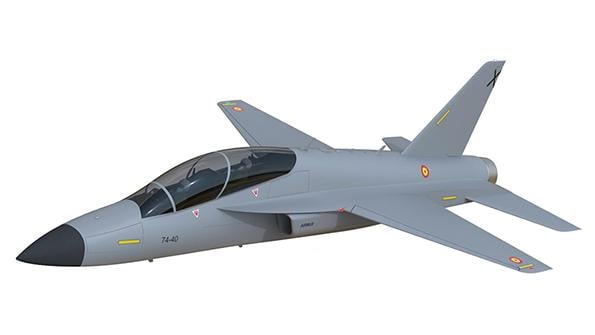
Airbus in Spain has proposed a new advanced jet trainer that it hopes will be the European answer to the Boeing-Saab T-7 Red Hawk.
- The AFJT would replace Spain’s SF-5 fleet in 2027-28
- The platform could use Eurojet’s EJ200 or Safran’s M88
Although the company designed its Airbus Future Jet Trainer (AFJT) around Spanish requirements, it believes the AFJT could also answer an expected need for Europe’s air forces, which continue to be largely reliant on platforms developed and built in the 1960s and 1970s—including the BAE Systems Hawk and Dassault Alpha Jet—and dependent on the Northrop T-38 Talon while training in the U.S.
Airbus has been quietly developing the AFJT for three years. The original concepts looked at how to replace Spain’s fleet of CASA C-101 Aviojets with an aircraft of similar performance to the Hawk. But when Madrid opted to replace the Aviojets with the Pilatus PC-21 turboprop last year, the focus shifted to replacing Spain’s fleet of Northrop SF-5 Freedom Fighters, currently used for lead-in fighter training.
The result is a clean-sheet, transonic-capable, single-engine design similar in configuration and size to both the T-7 and the Korea Aerospace Industries (KAI) T-50 Golden Eagle. Taking into consideration the AFJT’s maximum takeoff weight of about 7 metric tons, the development team is looking at either the Eurofighter’s Eurojet EJ200 engine or the Dassault Rafale’s Safran M88 as potential powerplants. Both would retain their afterburner modules.
The proposals easily could be written off as yet another jet trainer in an already crowded market. After all, along with the T-7, Turkish Aerospace Industries is developing its own T-50 look-alike in the form of the Hurjet, and Leonardo in Italy is advancing its M-345 and M-346 platforms. Furthermore, there are questions about whether such platforms are really needed as synthetic technologies advance.
But the AFJT has already received Madrid’s backing. The proposals are part of an agreement the government signed with Airbus at the end of July to maintain and, ultimately, strengthen the company’s presence. Along with purchasing new tankers and maritime patrol aircraft, the Spanish government has agreed to fund studies for the AFJT (AW&ST Aug. 17-30, p. 32).
“Taking into account the return on investment for the money that Spain would put into this program and the money that is coming back, we think it is more cost-effective than going out to the market,” says Abel Nin, head of the AFJT program at Airbus.
Airbus claims the program would return a large part of the investment in the aircraft back into the Spanish economy through taxes and fiscal contributions. The company adds that the AFJT’s development would help maintain skills and capabilities needed to support development of the Future Combat Air System (FCAS), in which Spain has an equal share with France and Germany. Madrid’s support for the AFJT has yet to be budgeted, but Airbus believes it can meet the Spanish Air Force’s target of replacing the SF-5 by 2028. The company plans to fly an AFJT prototype around 2025 and begin deliveries in 2027.
“This funding needs to be put into black and white,” Nin says. “We have people working with the government to establish what will be the next steps. . . . We are preparing everything in advance to be ready for development.”
Spanish requirements are for about 50 aircraft, says Raul Tena Martin, Airbus’ sales director for combat aircraft in Spain. But the potential is “far beyond Spain,” he notes, with a market for 500-800 aircraft. France continues to use the Alpha Jet, while Finland is flying early-model Hawks. Germany owns its own fleet of T-38 Talons based in the U.S. but has yet to decide whether to replace them with the T-7.
Along with the advanced training mission, the aircraft, Nin says, could also perform as a red-air aggressor and even in the light attack role, with engineers leaving a space in the nose for a radar.
Airbus sees the AFJT forming part of a wider training system that also includes training devices; support for live, virtual and constructive training; and the ability to download advanced training from frontline types currently in Spanish service, such as the Eurofighter Typhoon and the McDonnell Douglas EF-18 Hornet. In the future, the aircraft could prepare crews for flying the FCAS.
“We are trying to be cost conscious by thinking holistically,” Nin says. “If you can create a well-connected aircraft, then you can also do more operations in the flight simulator.”
Development of the AFJT would lean heavily on the Spanish supply chain: Compania Espanola de Sistemas Aeronauticos S.A. (CESA) could provide the landing gear and actuators; GMV would develop the flight control systems and software; Indra would supply the ground-based simulators; and Technobit would develop the communications and cockpit interface. Engine support could be provided through ITP Aero if the EJ200 is selected, since the company is a member of the Eurojet consortium that developed it.
Airbus envisions the use of a fly-by-wire flight control system as well as a wide-area display in the cockpit that could be adapted to show the cockpit layouts of other types to support training.


Comments
But no, make another one in a crowded market and run the cost up.
A400 anyone?
At some point the European Nato countries need to decide if defense is a jobs program or they want a credible defense.